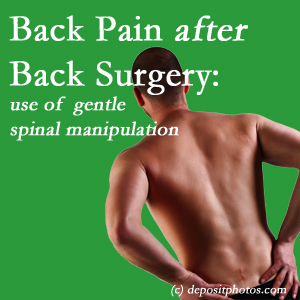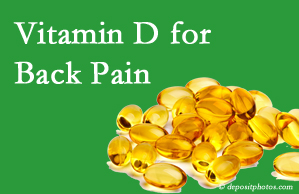
FAILED BACK SURGERY BACK PAIN RELIEF
Gentle spinal manipulation for back pain that stays or returns after back surgery - sometimes called
persistent post-surgical pain or post-surgical continued pain - is demonstrating effectiveness. And Cox® Technic as utilized at our San Jose chiropractic clinic is receiving attention for its pain-alleviating outcomes!
So have you undergone back surgery? Do you still experience back pain…or has it returned? You’re not alone, especially in wishing the pain would just go away and never return. Some will opt for more medical selections like surgery or pain meds or physical therapy, etc. Others will pursue non-medical options like spinal manipulation. A new meta-analysis of published data on the kinds of
spinal manipulation employed to treat back pain patients with persistent spine pain after lumbar surgery determined that spinal manipulation practitioners elected to use potentially gentler non-thrust techniques –
85% chose flexion-distraction (aka Cox® Technic) – over thrust techniques.
(1) A published study of 69 post-surgical patients managed with Cox® Technic recorded that in 11 visits over a 49 day treatment period 81% of the patients got more than 50% relief of pain. The mean percent of relief was 71.6% when the active treatment time was done and 70% at 2-year-follow-up. The relief lasted!
(2) The frustration of back pain is reasonable. The frustration of back pain after back surgery that was anticipated to get rid of it is even more frustrating. Chiropractic Solutions offers Cox® Technic to decrease the pain…
and the frustration!Listen to this PODCAST with Dr. Gary Stefanick on The Back Doctors Podcast with Dr. Michael Johnson as he describes the help his patient got with The Cox® Technic System of Spinal Pain Management.
TIP OF THE MONTH: Another Reason to Be Up on Your Vitamin D! LBP And Disc Degeneration
Higher vitamin D levels were documented to be associated with better physical performance in low back pain (LBP) sufferers with lumbar disc degeneration (LDD). Researchers calculated vitamin D levels and muscle strength in 200 participants. Those low in vitamin D took more time in the gait speed, chair stand, and timed-up-and-go (TUG) tests. (3) Postmenopausal women with vitamin D deficiency (especially those with less than 10 ng/mL which marked severe LDD and LBP) are noted to have LBP and LDD. Add in smoking, high body mass index, osteoporosis, and no D supplementation, and the moderate to severe pain was worse. (4) Another report indicated that frailty status and physical performance measures (gait speed and TUG) were significantly associated with vitamin D concentration. (5) Chiropractic Solutions asks: How’s your vitamin D level? Time to check it!
CONTACT Chiropractic Solutions
Set your next San Jose chiropractic visit with Chiropractic Solutions soon.


